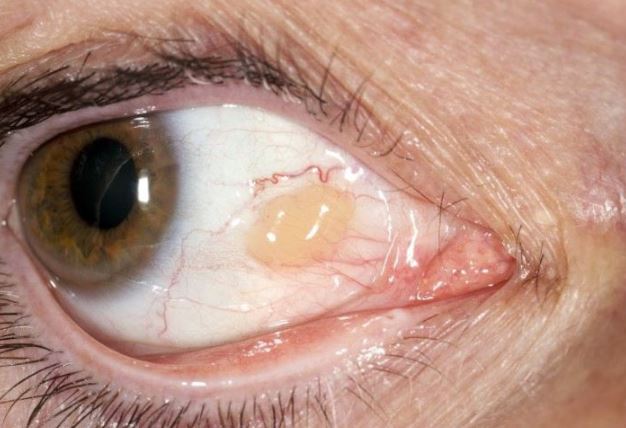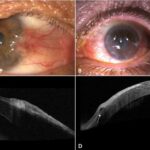Overview
Pterygium and Pinguecula are two of the most common conditions affecting the eyes, yet people often misunderstand them or interchange their diagnoses.
These two conditions can mostly be found in populations staying around the equator, tropical and subtropical areas. Though, it can affect everyone in the world it’s prevalence varies widely worldwide, ranging from 0.3 to 29 percent. In Singapore, the estimated prevalence is 10.1%, 30.8% in Japan, 14.49% in the Tibetan population in China, and 17.9% in the older Mongolian population at Henan county, China. So what exactly are Pterygium and Pinguecula?
Pterygium

Pronounced ‘tuh-rig-ee-um’ and colloquially known as “surfer’s eye” or “windshield wiper’s eye,” is a non-cancerous wedge-shaped fleshy growth on the conjunctiva (transparent mucous tissue covering the inner parts of the eyelids and the white parts of the eye). Pterygium is caused by ultraviolet (UV) rays mainly from the sun and environmental irritants such as dust or wind. Pterygium is mostly found in the nasal side of the eye (closer to the nose) but can occasionally be found on the temporal side of the eye (towards the ear) as well.
Pteygium can be graded depending on the extent of the growth, and according to Sejal Maheshwari, below is one of the grading system:
- Grade I: pterygium between the limbus and a point midway between the limbus and the pupillary margin (temporal pupillary margin for temporal pterygium, and nasal pupillary margin for nasal pterygium)
- Grade II: The head of the pterygium is present between a point midway between the limbus and the pupillary margin
- Grade III: pterygium that crosses the pupillary margin
Eye doctors (Optometrists or Ophthalmologists) may use this grading to inform their treatment plans.
Pinguecula

“Pinguecula, pronounced ‘ping-gweh-kyuh-luh,’ is a yellowish raised tissue growth on the conjunctiva. It generally remains benign and, like pterygium, results from exposure to Ultraviolet A (UVA) and Ultraviolet B (UVB), which have longer and shorter wavelengths, respectively, and are associated with skin ageing and burning. The growth is a composition of protein, fat or calcium or a combination of all three. It can be located both nasally and temporally of the eye.
Signs and Symptoms
Pterygium
- Redness and Irritation: Persistent redness and irritation on the surface of the eye, often accompanied by a gritty or itchy sensation.
- Foreign Body Sensation: Individuals may experience the feeling of having a foreign body, like sand or grit in their eyes.
- Blurred or Distorted Vision: As the pterygium grows, it extends onto the cornea, leading to blurred or distorted vision.
- Dryness and Burning Sensation: Pterygium can contribute to dryness in the affected eye, accompanied by a burning or stinging sensation.
- Raised, Fleshy Growth: Physical observation of a raised, fleshy growth on the conjunctiva
- Light Sensitivity (Photophobia): Increased sensitivity to light may develop as a result of the irritation caused by pterygium.
Pinguecula
Pinguecula exhibits Foreign body sensation, Dryness and Burning Sensation, Light Sensitivity and Blurred or Distorted vision as listed under the signs and symptoms of Pterygium. Additionally, it has the following characteristics:
- Yellowish Bumps on Eye Surface: Pinguecula generally appear as yellowish or white bumps on the conjunctiva.
- Slow or Gradual Growth: Pinguecula typically exhibits slow or gradual growth over time, often without causing significant symptoms.
Differences between Pterygium and Pinguecula
Below is a table of the differences between Pterygium and Pinguecula
| Characteristic | Pterygium | Pinguecula |
|---|---|---|
| Appearance | Typically appears as a fleshy wedge-shaped or triangular-shaped tissue growth on the nasal or temporal side of the eye. | Appears as a yellowish or white bump on the conjunctiva, usually on the nasal side of the eye. |
| Growth | Can progressively grow onto the cornea to cause visual disturbances. | Typically remains stable in size and does not grow onto the cornea. |
| Vascularity | Often has prominent blood vessels within the fleshy tissue. | May have minimal vascularity, and blood vessels are not as prominent. |
| Histology (Microscopic Examination) | Microscopic examination reveals a proliferation of fibrovascular tissue. | Microscopic examination shows elastotic degeneration of collagen. |
| Colour | Can vary in colour, including pink, red, or even brown. | Typically appears yellowish or white. |
| Recurrence | Can recur after surgical removal. | Typically does not recur after conservative management. |
Prevention of Pterygium and Pinguecula
UV Protection
- Wear sunglasses which has 100% UVA and UVB protection. Go for wrap-around styles when selecting your sunglasses as this offers protection from all angles. You can combine your sunglasses with a wide-brimmed hat, especially during peak sunlight hours between 10 am and 4 pm. The use of UV protection sunglasses not only prevents the development of pterygium and pinguecula but also contributes to overall eye health by reducing the risk of cataracts and other UV-related eye conditions. Avoid prolonged exposure to direct sunlight, especially during peak UV hours.
Dust and Wind Protection
- In dusty or windy environments, wear protective eyewear such as safety glasses or goggles. Wearing protective eyewear prevents pterygium and Pinguecula by minimizing direct contact with potential irritants while performing outdoor activities like driving.
Stay Hydrated
- Staying hydrated helps prevent pterygium and pinguecula. Dehydration can lead to dry eyes, making the eyes more susceptible to irritation and inflammation which further causes pterygium and Pinguecula. Additionally, hydration contributes to general well-being, promoting overall health and minimizing the risk of various eye-related issues associated with dryness and discomfort.
Use Lubricating Eye drops
- Dry eyes are a common precursor for pterygium and pinguecula, and lubricating eye drops provide essential moisture to the eyes, preventing dryness and discomfort. By applying lubricating eye drops you reduce the likelihood of irritation and inflammation that can contribute to the development of pterygium and pinguecula.
Treatment Options
Conservative Management
- In most cases pterygium and pinguecula are observed by eye doctors (optometrist and ophthalmologist), it does not require treatment but your doctor prescribes lubricating eye drops or artificial tears to provide relief from dryness and irritation. This solution helps maintain adequate moisture on the eye’s surface, reducing discomfort associated with the conditions.
Anti-Inflammatory Medications
- In cases where the Pterygium or Pinguecula is inflamed, topical anti-inflammatories, such as corticosteroid eye drops can be applied directly to the affected area, reducing redness and irritation. In more severe cases or when systemic involvement is present, oral anti-inflammatory medications may be considered by your doctor. These medications work to suppress the immune response, mitigating inflammation and promoting patient comfort. However, the choice of medication and route of administration are tailored to the individual’s condition.
Surgical Intervention
- Surgical intervention is a significant treatment option for both pterygium and pinguecula when conservative measures prove insufficient. For pterygium, surgical removal becomes necessary if the growth extends onto the cornea, causing visual impairment or discomfort. Various surgical techniques, such as conjunctival autografts or amniotic membrane transplantation, aim to minimize the risk of recurrence and promote optimal healing. In the case of pinguecula, surgical removal is less common and typically reserved for instances of inflammation or persistent discomfort. Surgical procedures for both conditions are carefully tailored to the individual’s specific needs and the extent of the growth, highlighting the importance of a thorough assessment by an eye care professional to determine the most suitable approach for effective and lasting results.




